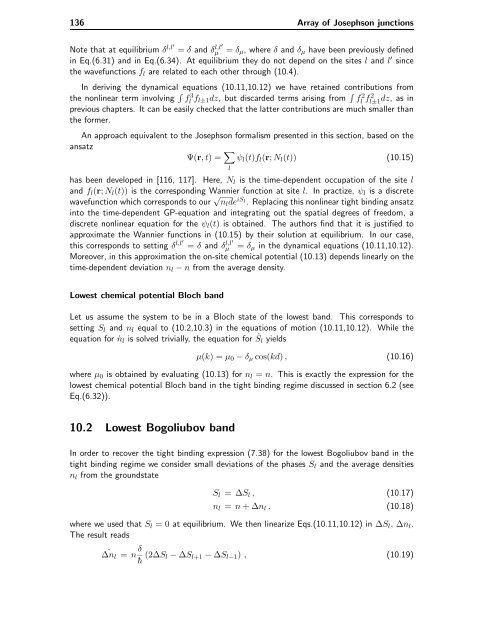Bose-Einstein Condensates in Rotating Traps and Optical ... - BEC
Bose-Einstein Condensates in Rotating Traps and Optical ... - BEC
Bose-Einstein Condensates in Rotating Traps and Optical ... - BEC
You also want an ePaper? Increase the reach of your titles
YUMPU automatically turns print PDFs into web optimized ePapers that Google loves.
136 Array of Josephson junctions<br />
Note that at equilibrium δ l,l′<br />
= δ <strong>and</strong> δ l,l′<br />
µ = δµ, where δ <strong>and</strong> δµ have been previously def<strong>in</strong>ed<br />
<strong>in</strong> Eq.(6.31) <strong>and</strong> <strong>in</strong> Eq.(6.34). At equilibrium they do not depend on the sites l <strong>and</strong> l ′ s<strong>in</strong>ce<br />
the wavefunctions fl are related to each other through (10.4).<br />
In deriv<strong>in</strong>g the dynamical equations (10.11,10.12) we have reta<strong>in</strong>ed contributions from<br />
the nonl<strong>in</strong>ear term <strong>in</strong>volv<strong>in</strong>g f 3 l fl±1dz, but discarded terms aris<strong>in</strong>g from f 2 l f 2 l±1dz, as<strong>in</strong><br />
previous chapters. It can be easily checked that the latter contributions are much smaller than<br />
the former.<br />
An approach equivalent to the Josephson formalism presented <strong>in</strong> this section, based on the<br />
ansatz<br />
Ψ(r,t)= <br />
ψl(t)fl(r; Nl(t)) (10.15)<br />
l<br />
has been developed <strong>in</strong> [116, 117]. Here, Nl is the time-dependent occupation of the site l<br />
<strong>and</strong> fl(r; Nl(t)) is the correspond<strong>in</strong>g Wannier function at site l. In practize, ψl is a discrete<br />
wavefunction which corresponds to our √ nldeiSl. Replac<strong>in</strong>g this nonl<strong>in</strong>ear tight b<strong>in</strong>d<strong>in</strong>g ansatz<br />
<strong>in</strong>to the time-dependent GP-equation <strong>and</strong> <strong>in</strong>tegrat<strong>in</strong>g out the spatial degrees of freedom, a<br />
discrete nonl<strong>in</strong>ear equation for the ψl(t) is obta<strong>in</strong>ed. The authors f<strong>in</strong>d that it is justified to<br />
approximate the Wannier functions <strong>in</strong> (10.15) by their solution at equilibrium. In our case,<br />
this corresponds to sett<strong>in</strong>g δl,l′ = δ <strong>and</strong> δl,l′ µ = δµ <strong>in</strong> the dynamical equations (10.11,10.12).<br />
Moreover, <strong>in</strong> this approximation the on-site chemical potential (10.13) depends l<strong>in</strong>early on the<br />
time-dependent deviation nl − n from the average density.<br />
Lowest chemical potential Bloch b<strong>and</strong><br />
Let us assume the system to be <strong>in</strong> a Bloch state of the lowest b<strong>and</strong>. This corresponds to<br />
sett<strong>in</strong>g Sl <strong>and</strong> nl equal to (10.2,10.3) <strong>in</strong> the equations of motion (10.11,10.12). While the<br />
equation for ˙nl is solved trivially, the equation for ˙ Sl yields<br />
µ(k) =µ0 − δµ cos(kd) , (10.16)<br />
where µ0 is obta<strong>in</strong>ed by evaluat<strong>in</strong>g (10.13) for nl = n. This is exactly the expression for the<br />
lowest chemical potential Bloch b<strong>and</strong> <strong>in</strong> the tight b<strong>in</strong>d<strong>in</strong>g regime discussed <strong>in</strong> section 6.2 (see<br />
Eq.(6.32)).<br />
10.2 Lowest Bogoliubov b<strong>and</strong><br />
In order to recover the tight b<strong>in</strong>d<strong>in</strong>g expression (7.38) for the lowest Bogoliubov b<strong>and</strong> <strong>in</strong> the<br />
tight b<strong>in</strong>d<strong>in</strong>g regime we consider small deviations of the phases Sl <strong>and</strong> the average densities<br />
nl from the groundstate<br />
Sl =∆Sl , (10.17)<br />
nl = n +∆nl , (10.18)<br />
where we used that Sl =0at equilibrium. We then l<strong>in</strong>earize Eqs.(10.11,10.12) <strong>in</strong> ∆Sl, ∆nl.<br />
The result reads<br />
˙<br />
∆nl = n δ<br />
¯h (2∆Sl − ∆Sl+1 − ∆Sl−1) , (10.19)




